Nebius Group prices $1 billion share offering at $92.50 per share
Introduction & Market Context
Evergy Inc. (NYSE:NASDAQ:EVRG) reported second-quarter 2025 results on August 7, showing a year-over-year decline in earnings while maintaining its full-year guidance amid an expanding economic development pipeline. The utility, which serves customers in Kansas and Missouri, faced headwinds from unfavorable weather conditions and higher expenses but highlighted strong regulatory outcomes and substantial growth opportunities.
The company’s stock has shown resilience in recent trading, closing at $73.25 on August 6, near its 52-week high of $73.66 and well above its 52-week low of $57.28. This performance comes despite Evergy’s Q1 2025 results missing analyst expectations, when the company reported adjusted EPS of $0.54 against a forecast of $0.66.
Quarterly Performance Highlights
Evergy reported second-quarter 2025 GAAP earnings per share (EPS) of $0.74 and adjusted EPS of $0.82, compared to $0.90 in the same period last year. The company cited several factors affecting quarterly performance, including recovery of regulated investments and load growth, offset by unfavorable weather, higher operations and maintenance expenses, increased interest expense, and depreciation and amortization.
As shown in the following breakdown of quarterly earnings drivers:
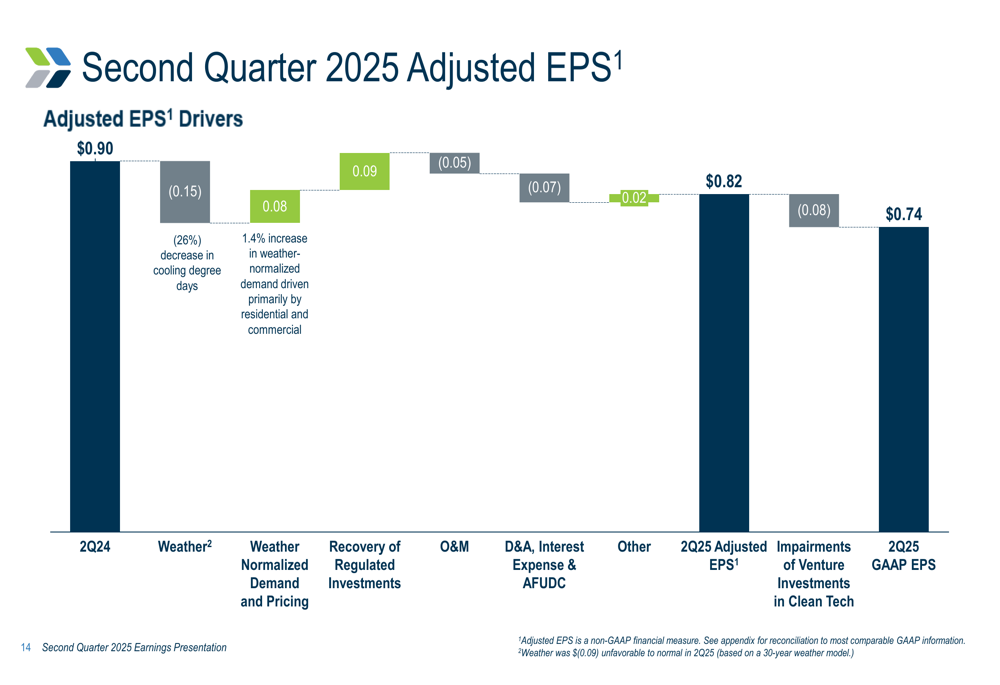
Weather had a significant negative impact of $0.15 per share compared to Q2 2024, with cooling degree days down 26%. This was partially offset by weather-normalized demand growth of 1.4% and pricing benefits, which contributed $0.08 per share. The recovery of regulated investments added $0.09 per share, while higher O&M expenses reduced EPS by $0.05, and increased D&A, interest expense, and AFUDC reduced EPS by $0.07.
Notably, impairments of venture investments reduced adjusted EPS by $0.08. Despite these challenges, Evergy reaffirmed its 2025 adjusted EPS guidance range of $3.92 to $4.12.
Retail sales showed encouraging trends in the second quarter, with weather-normalized demand growth of 2.6%, driven by residential (1.3%) and commercial (2.6%) sectors, though industrial demand declined slightly (-0.9%).
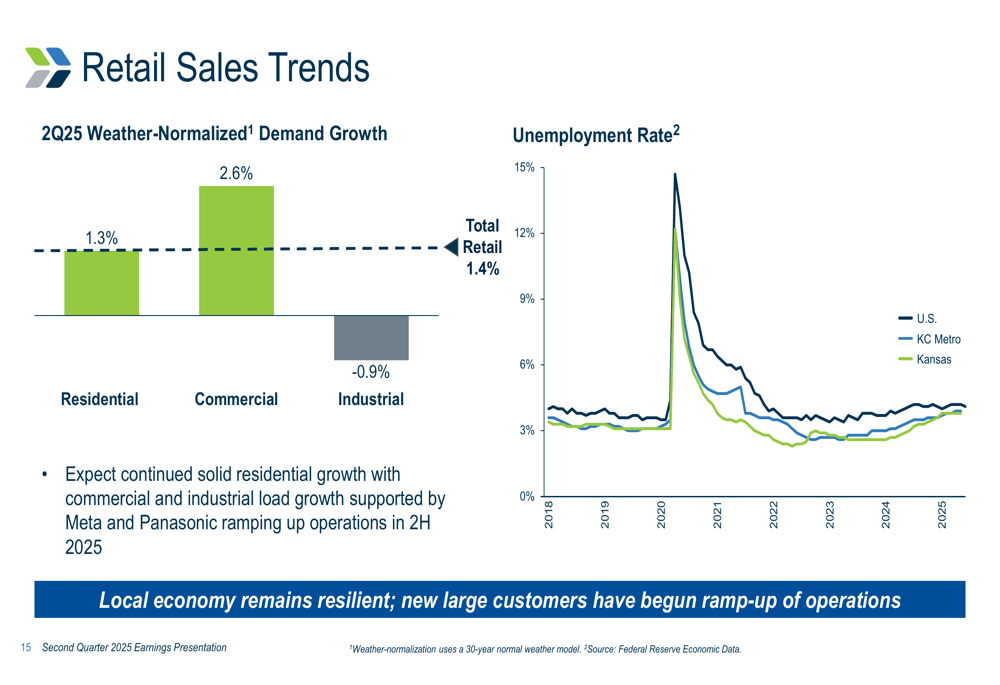
Economic Development Pipeline
A significant highlight of Evergy’s presentation was its expanding economic development pipeline, which has grown from approximately 12.2 GW to over 15 GW. The company identified a transformative 4-6 GW opportunity with Tier 1 large load customers, providing a substantial 10-year growth roadmap.
The economic development pipeline is illustrated in the following chart:
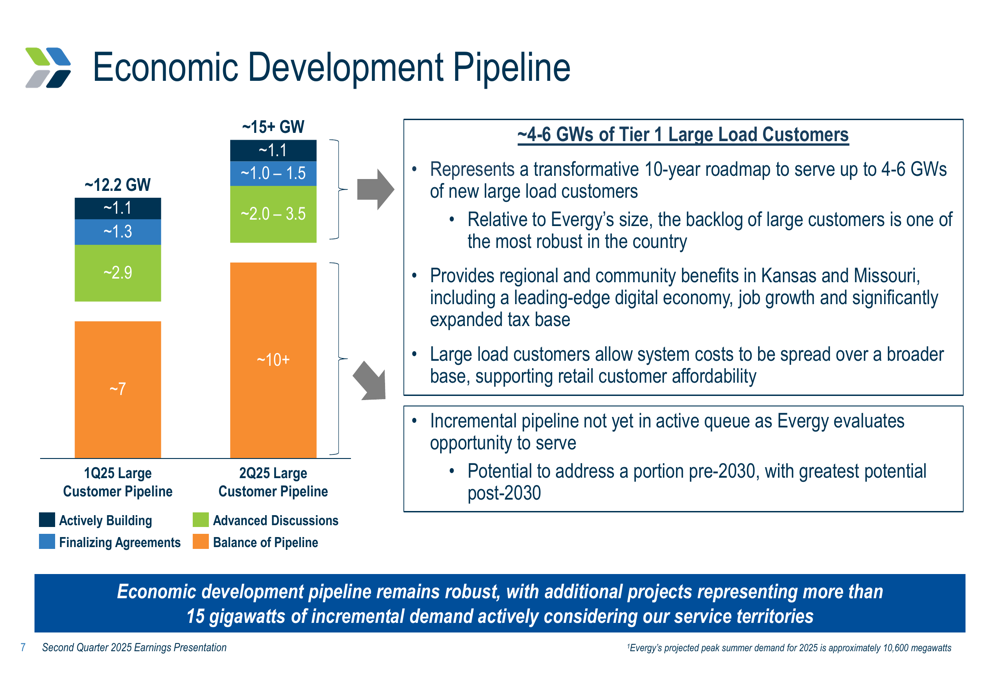
The pipeline is categorized into customers who are actively building (~1.1 GW), finalizing agreements (~1.0-1.5 GW), in advanced discussions (~2.0-3.5 GW), and the balance of the pipeline. Evergy noted that its projected peak summer demand for 2025 is approximately 10,600 megawatts, underscoring the significant scale of these potential additions.
For customers in the "actively building" category, construction is completed for two of three customers, with operations expected to start in the first half of 2026. These customers are expected to reach approximately 500 MW of peak demand by 2029. The "finalizing agreements" category primarily consists of two large data centers with various service agreements and approximately $200 million of commitments, potentially adding 600 MW of peak demand by 2029.

Importantly, Evergy’s current 2-3% demand growth forecast through 2029 only includes approximately 500 MW from actively building customers. Load from customers in the finalizing agreements category would be additive to this forecast, representing an approximately 600 MW incremental opportunity through 2029.
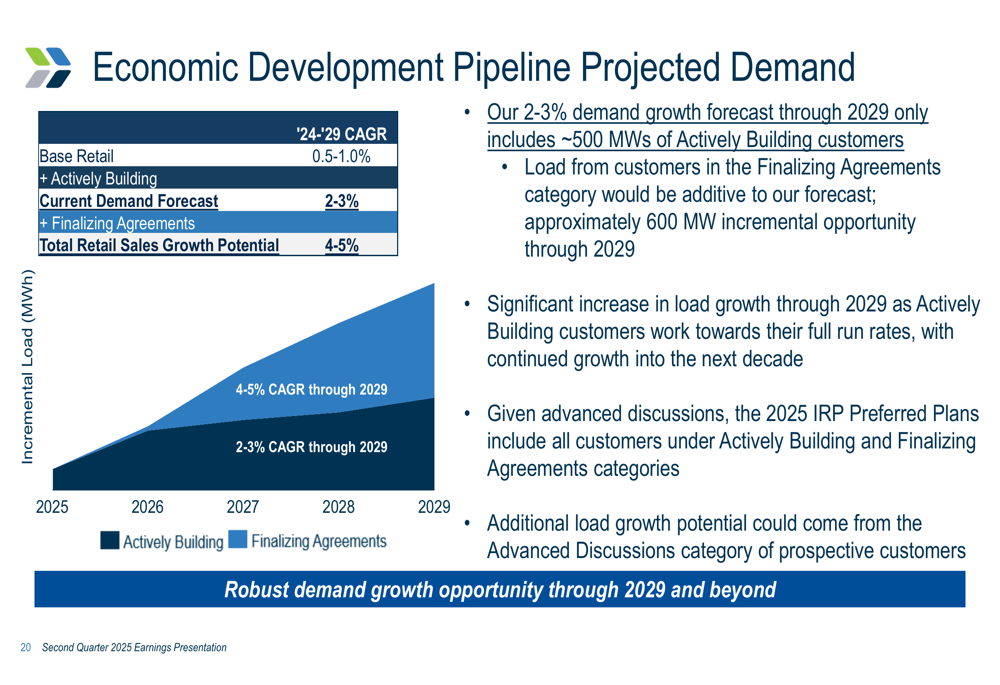
Regulatory and Generation Updates
Evergy highlighted several regulatory wins during the quarter. A unanimous settlement agreement was filed on July 16 for the Kansas Central Rate Review, resulting in a $128 million net revenue increase. While the settlement is silent on ROE and capital structure, it establishes that a 9.7% ROE will be used for transmission delivery charge filings, and the pre-tax rate of return for Plant-in-Service Accounting (PISA) is 8.45%. A commission order is anticipated by September 29.
The company also received approvals for several generation projects, including natural gas and solar facilities. These projects represent a total of 2,184 MW of capacity with commercial operation dates ranging from 2027 to 2030.

Evergy emphasized its three core strategic tenets—affordability, reliability, and sustainability—as guiding principles for its operations and investments. The company aims to maintain affordable rates while investing in infrastructure, target top-tier performance in reliability and customer service, and advance an "all-of-the-above" generation portfolio with a target of net zero CO2e by 2045 for scope 1 and scope 2 emissions.
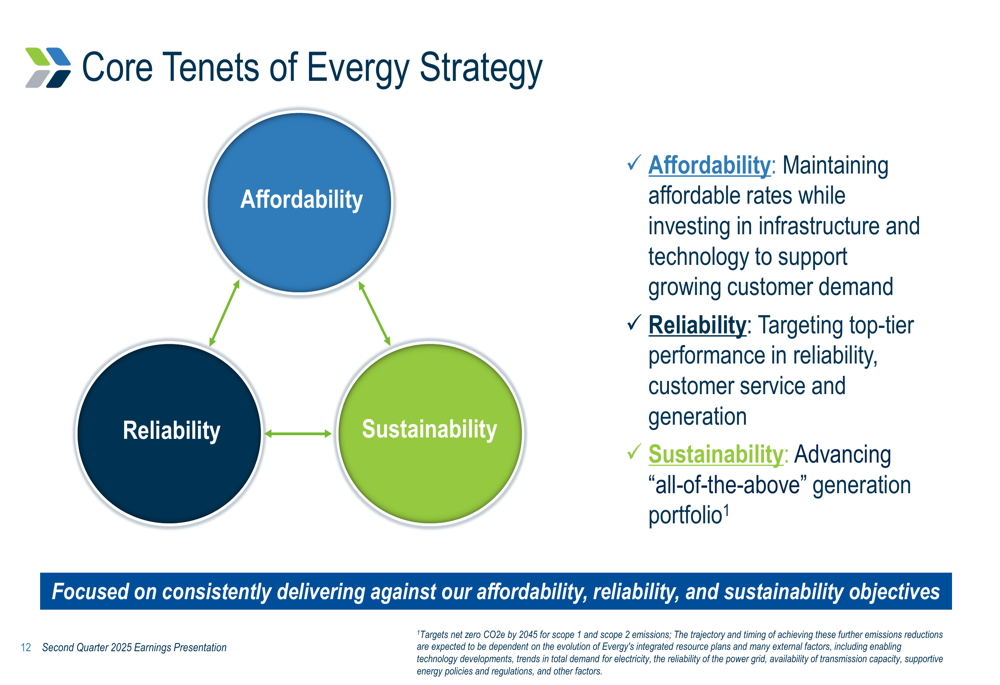
Financial Outlook and Strategy
Despite current headwinds, Evergy maintained a positive long-term outlook, reaffirming its 2025 adjusted EPS guidance of $3.92-$4.12 and projecting a 4-6% EPS compound annual growth rate (CAGR) through 2029, with expectations to be in the top half of this range.
The company’s growth outlook is summarized in the following chart:
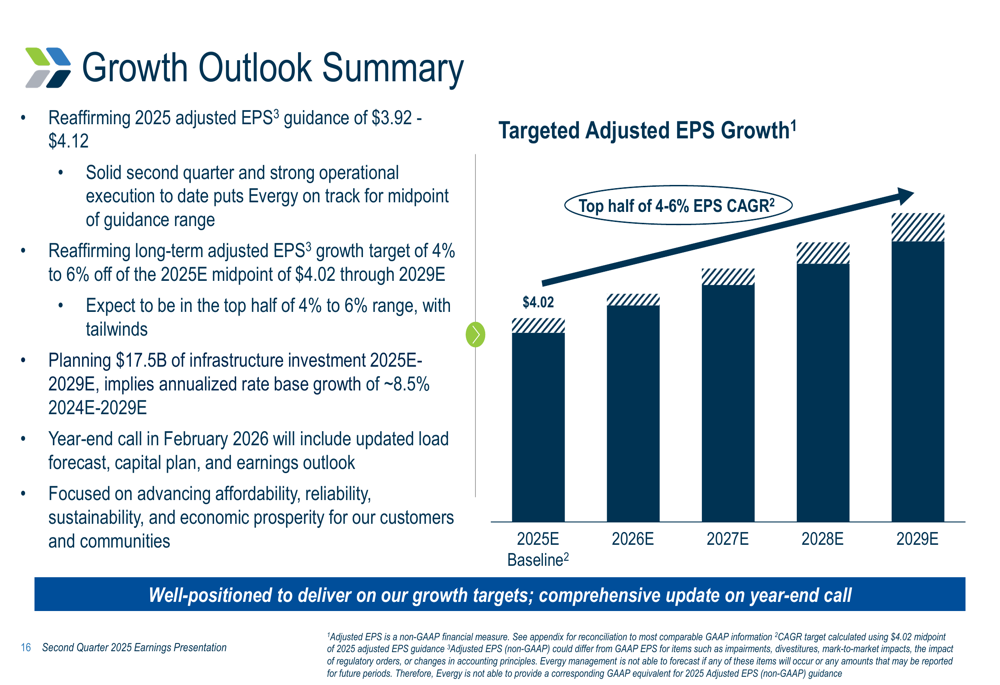
To support this growth, Evergy plans $17.5 billion in infrastructure investments from 2025 to 2029. The financing plan includes $12.5 billion from operations, $5.8 billion in incremental debt, and $2.8 billion in equity and equity-like securities, while paying out $3.6 billion in dividends (targeting a 60-70% payout ratio).
The company maintains strong credit metrics, with an estimated CFO pre-working capital to debt ratio of approximately 15.0%, above Moody’s downgrade threshold of 14%. Debt maturities are well-structured, and the company holds solid credit ratings from both Moody’s and S&P Global.
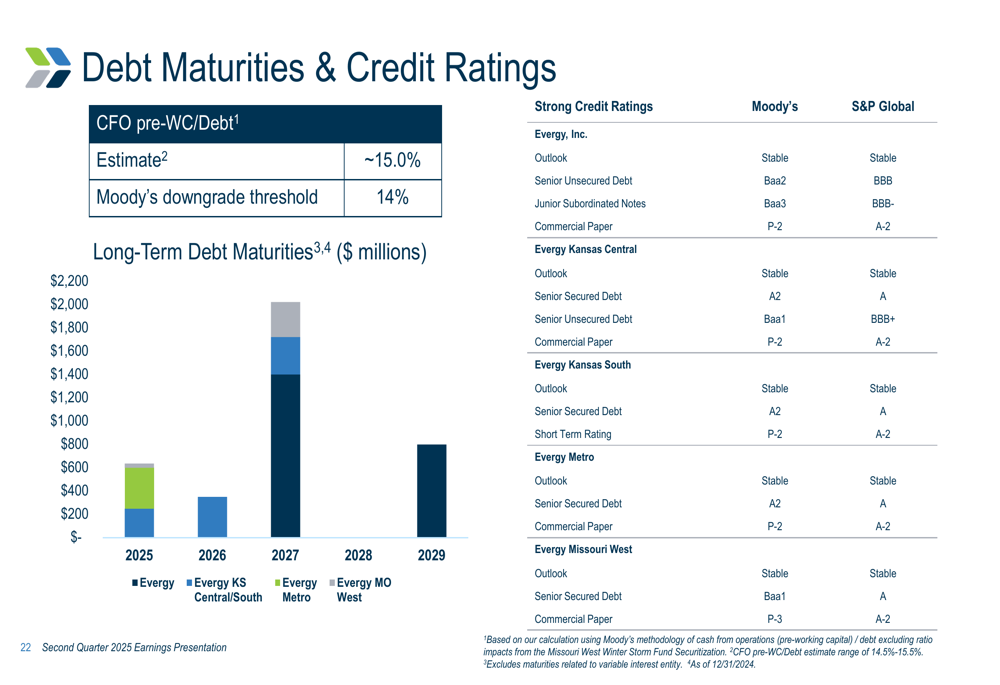
Evergy’s five-year capital investment plan allocates funds across various categories, with significant portions directed to distribution ($926 million in 2025), transmission ($547 million), and new generation ($501 million). The company plans to provide a comprehensive update on load and EPS growth, along with its five-year capital plan for 2026-2030 and financing plan, during its year-end call.
Overall, while Evergy faces near-term challenges from weather impacts and rising costs, its expanding economic development pipeline, regulatory successes, and strategic investments position the company for sustained long-term growth.
Full presentation:
This article was generated with the support of AI and reviewed by an editor. For more information see our T&C.
